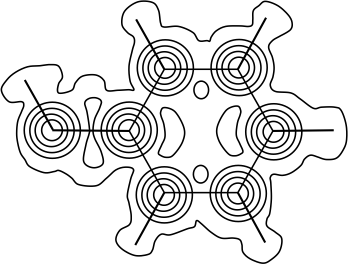The electron densities of atoms in a crystal are Fourier transforms of the structure factor.

In the article on scattering factor, we have restricted the electron density ρ to a lattice point, which is too simplistic. We have also described the scattering factor (eq27) as
or in its integrated form
If we now extend the distribution of ρ through the unit cell, eq40 becomes the structure factor:
where ρ’ = ρ(xyz) is the electron density at coordinates xyz in the unit cell and , i.e.
Let dV be an infinitesimal volume of the unit cell with edges dx, dy, dz that are parallel to the unit cell axes of a, b, c (volume of unit cell is V). The ratio of dV/V must be equal to (dxdydz)/abc and we can rewrite eq41 as
A Fourier series is an expansion series used to represent a periodic function and is given by:
or by its complex form
Due to the repetitive arrangement of atoms in a crystal, the electron density in a crystal is also periodic and can be expressed as a Fourier series:
In three dimensions, eq43 becomes
Substitute eq44 in eq42
If n ≠ –h,
which makes Fhkl = 0.
Similarly, Fhkl = 0 if m ≠ -k or o ≠ -l. Therefore, the surviving term in the triple summation in eq45 corresponds to the case of n = –h, m = –k, o = –l, giving
When n = –h, m = –k, o = –l, eq44 becomes
Since
Substitute eq46 in eq47
Since the limits of the integrals in eq42 can be changed to run from to
without affecting the values of the integrals because
is zero outside the crystal, we have
Eq48 and eq48a are a Fourier transform pair. As mentioned in the previous article, the intensity of a diffraction signal is proportional to the square of the magnitude of the three-dimensional structure factor, i.e. . If we know the value of Fhkl (which in principle is the square root of the intensity of a peak from an X-ray diffraction experiment
) and having indexed the plane contributing to this intensity peak (i.e. knowing the h, k, l values), we can determine ρ(xyz) using a mathematical software. The solution to ρ(xyz) is an electron density map that elucidates bond lengths and bond angles of the compound. However, a problem called the phase problem arises.
